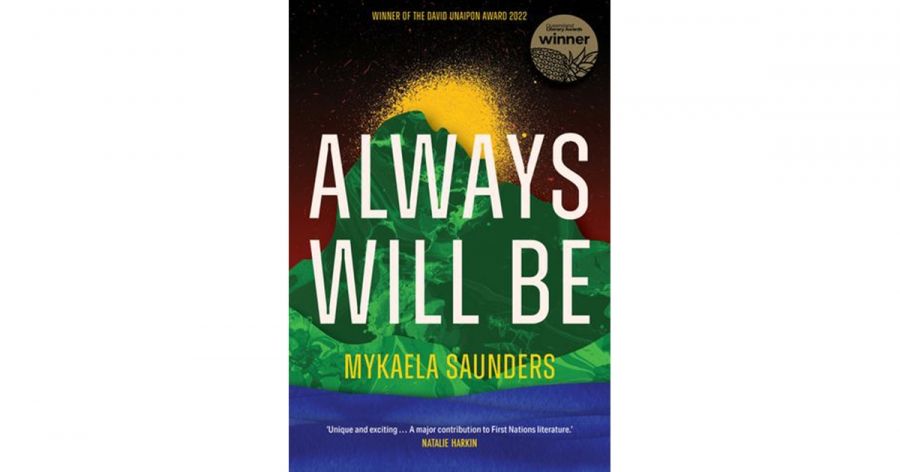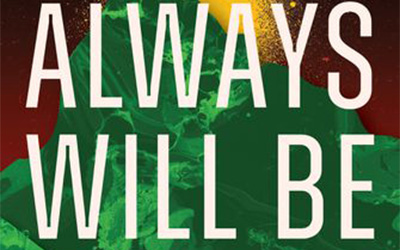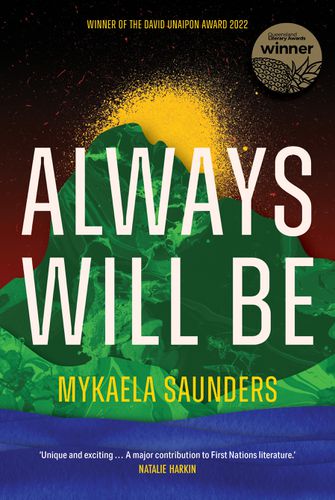
- Free Article: No
- Contents Category: Fiction
- Review Article: Yes
- Article Title: Across time
- Article Subtitle: Mykaela Saunders’s new short story collection
- Online Only: No
- Custom Highlight Text:
There has been talk in recent years about so-called Indigenous Futurism. Referencing Afro-Futurism, futurist fiction that imagines a new postcolonial Africa, the Indigenous version imagines a postcolonial world for Indigenous people, a future where the world is the way it should always have been. One quirk, however, is that Indigenous Futurism leans on Indigenous notions of time, an eternal now in which past and future are mere directions. Writers of Indigenous Futurism know that it’s not only possible to imagine the future and the past at the same time, but that it is part of cultural practice.
- Featured Image (400px * 250px):

- Alt Tag (Featured Image): Claire G. Coleman reviews ‘Always Will Be’ by Mykaela Saunders
- Book 1 Title: Always Will Be
- Book 1 Biblio: University of Queensland Press, $32.99 pb, 312 pp
- Book 1 Cover Small (400 x 600):

- Book 1 Cover (800 x 1200):

Always Will Be, by Mykaela Saunders, is centred around Bunjalung Country; specifically, the land now known as the ‘Tweed Valley’ region of far north New South Wales (Saunders has connections to the Tweed and has grown and lived there, but is descended from the Dharug people of the lands around what is now known as Sydney). Driving north along the Tweed coast, you pass through subtropical bushland, the sort of place loved by alternative lifestylers and surfers, until you hit the Queensland border and things change abruptly, bushland and surf hippies giving way to the high rises and tourist traps of the Gold Coast – a surreal experience Saunders is well aware of.
The title is the second clause of a powerful Indigenous land-rights chant: ‘Always was, always will be, Aboriginal land.’ Attributed to Barkinji elder Jim Bates, this is a reminder that Indigenous sovereignty was never ceded, and that we will be here forever. Our culture grew on our ancestral lands where we belong, and we will never leave our ancestral land, and those who are not in their homelands, those whose homelands no longer exist, can find more homes with other Indigenous people but still on Indigenous land. This continent is Indigenous land and always will be.
The book’s title and its history assert not only the author’s politics but also the overarching theme in this collection. The reader is invited to imagine the coming world, the natural end of the Anthropocene in which global warming is causing or has caused the near total collapse of our species. Global warming, social collapse, even environmental damage from ill-considered attempts to correct global warming are imagined, with the traditional owners and other Gooris from the Tweed coast and hinterland surviving as best they can.
Multiple apocalypses and multiple responses to the apocalypse are shown, connected and interconnected, woven together; reminding us the Anthropocene is everywhere and across all time.
Yet there is hope in the collection, and that hope, again flagged in the title, is the story of the book. Every story shows ways the blackfellas of the area can survive, and even thrive, using their generationally trained survival instincts, including those gained by resisting colonisation, to fight back. Nearly every story shows at least part of a path towards decolonisation. In Saunders’s world, Aboriginal people carry the cultural tools to survive the apocalypse. It is this, and our connection to Country, culture, and family, that empowers us.
No book is perfect. I would have liked to see more lyricism, and perhaps one more edit, to give these powerful stories the strength and attention they deserve. The work might have been more culturally powerful if Saunders had written stories of her own ancestral Country, the lands that first suffered the impacts of colonisation on this continent, but it is understandable to write about the community that has welcomed you, as communities in the Tweed of Always Will Be give sanctuary to people from other homelands.
The style reminds us of oral storytelling: from the first moment of reading, it felt like we were yarning around the fire. In this way, it connects with the storytelling styles of Alexis Wright and Kim Scott, who bring our grandparents’ storytelling into modern literature. Our ancestors’ stories carry the law, they carry knowledge, they tell us how best to live.
We will always be here, even as colonisation is followed by the Anthropocene, even as the colonisers destroy themselves and threaten to take us with them, even as the world becomes almost intolerable for humanity. We are Indigenous, we have survived worse, we will survive this. Always Will Be might not show the how – it’s not a survival manual – but it does show the why, what is important for our culture, and what we need to save. We are the land; we can save the land by saving the people.
In the end, the most important thing is the message, not only that this continent always was and always will be Indigenous land, but that we can survive the coming apocalypse and it will be our Aboriginality that gives us the skills and culture to do whatever we need to do to survive. Our connection to culture, to land and to family is important, our stories, that give us the tools to survive are important; our law, which helps us to live in harmony with others, is important. Our culture and families are what we have fought to protect for generations against colonisation. The Anthropocene, in which the colony is also destroying itself, is merely the latest challenge.
The final story, ‘Kinship Festival’, ends the book with a strong overarching statement that brings the stories, and all Indigenous people, home to culture, and we know that not only can we survive this latest apocalypse, but we can imagine using it to regain the sovereignty we never ceded.
Always was, always will be, Aboriginal land.


Comments powered by CComment